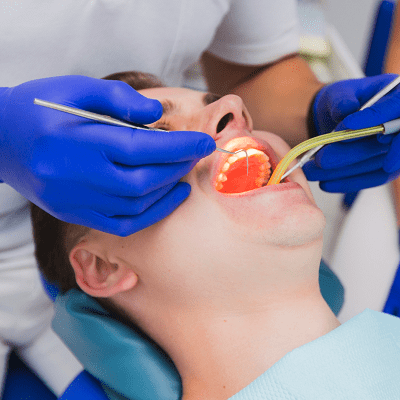
Tooth Filling in Islamabad fall under restorative dentistry and are used to repair cavities, broken, and chipped teeth. Fillings help prevent further decay, restore tooth function and integrity, relieve sensitivity, and stop pain.
With that being said, explore the dental filling procedure, benefits, cost, and filling materials with us.
Understanding dental fillings:
Dental fillings repair cavities by restoring damaged or decayed areas of the tooth. The dentist removes the decayed or damaged part of the tooth, cleanses the area, and then fills in the gap with the specific filling material.
Benefits of Tooth filling in Islamabad:
- Dental fillings repair damaged and decayed teeth.
- Restores teeth strength and functionality.
- Prevents further cavities and tooth decay.
- Tooth-coloured filling also looks sophisticated.
- Early filling can prevent teeth from requiring more complex treatments.
- Enhance the appearance of your teeth.
- Restore natural tooth structure.
- Give strength to weakened teeth.
- Lasts for 10 to 20 years.
Risks associated with Dental fillings:
- The tooth may feel sensitive for a few days after filling.
- Minor gum soreness in the area.
- Your teeth will feel sore when eating or drinking something hot and cold.
These side effects are just temporary and will subside within 2 to 3 days. However, if you experience intense pain when biting down, it may mean that the new filling interferes with your bite. This accounts for the reshaping of filling.
Dental filling procedure at an Dental Clinic Islamabad:
Consultation and Assessment: The initial step in our dental filling procedure is the consultation with the best dentist Islamabad, and you will often need to undergo X-rays to determine the severity of the decayed tooth. These sessions will help your dentist create a customized treatment plan suitable for your case.
It is better to get teeth cleaning treatment before getting a tooth filling in Islamabad. A Dentist removes the decayed part of the teeth and then replaces that empty space with a dental filling. This creates a clean canvas for filling the decayed tooth.
To ensure a painless procedure, local anesthesia is administered around the affected tooth. Even if you decide not to take local anaesthesia, we have methods to make the procedure painless. We do this by using a slow-speed handpiece, which can be a laser, drill, or abrasion tool. Which tool will be used will come down to the location and severity of your tooth decay, and the dentist’s skill with a particular tool.
The dentist will remove the decayed part of your tooth by using a slow or high-speed handpiece, depending on your needs. After the removal, the dentists will check for the successful removal by a process called excavation of the cavity, which involves probing the entire cavity.
After the removal, the dentist will clean the cavity of any potential germs or debris to prepare it for the filling material. The particular filling materials will be molded to match your teeth’s natural contours. After the filling, it is further polished so that its finish matches the shiny appearance of the real tooth.
If the cavity removed is close to the pulp, then the dentist will give you a lining to protect the nerve that is close to the root. The lining can be of either some glass ionomer cement GIC, composite resin, or calcium hydroxide.
Type of dental filling material provided at Dental Clinic Islamabad:
At the dental clinic Islamabad, we have plenty of dental filling materials. The choice of a dental filling for a particular individual will be decided on the first consultation by the dentists after assessing the decayed tooth.
Direct filling:
Direct filling is a procedure completed in a single session without requiring a temporary restoration.
Gold fillings:
Advantages:
- Highly durable.
- Last 10 to 15 years.
- Gold in colour.
- Contains gold mixed with other metals like silver, tin, copper or palladium.
- Better for your posterior teeth.
Disadvantages:
- Gold fillings are expensive.
- Costs you 5-8 times more than other filling materials.
- Gold filling can not be done in one session.
- It requires 2 or 3 visits to the dentist.
Amalgam Fillings:
Advantages:
- Durable and lasts 10-15 years.
- Silver in colour.
- Contains mercury mixed with silver, tin, zinc, and copper.
- Can withstand masticatory forces due to their strength.
- Affordable than composite fillings.
Disadvantages:
- Due to its silver color, it does not match the color of the teeth.
- Amalgam fillings require more thorough preparation of the tooth structure.
- Amalgam fillings tend to expand and contract.
Resin-based composite:
Advantages:
- Tooth-colored.
- They come in different shades.
- It is easier to match the shade with your teeth colour.
- Consists of a resin base with powdered quartz, silica, or glass.
- It is the first choice to fill the anterior teeth.
- Do not require extra preparation.
- Best for front teeth and broken/ chipped teeth.
Disadvantages:
- Not as durable.
- Lasts only 5 to 10 years.
- In case of resin-based filling, you can’t whiten the teeth later with whitening treatments.
- In the case of resin-based composites, a dental curing light is used to harden the material.
Other dental fillings:
Glass ionomer cement:
- Tooth colored.
- Made up of acrylic.
- Made of silica glass powder.
- Weaker than composite, gold, and amalgam.
- Perfect for adults and kids who have cavities below the gum line.
Porcelain fillings;
- Ceramic fillings are made from porcelain
- Tooth colored
- contains a mixture of minerals like feldspar, quartz, and kaolin.
- Expensive and costs as much as a gold filling.
- They need more dentist visits, too.
Indirect fillings
Whereas in indirect filling, the dentist places indirect fillings in a filling without putting them in your mouth. Unlike direct filling, this one takes two dentist appointments. One is to take dental impressions, and another is to fill directly. Indirect filling is suitable for those who have severe decay and damage but can’t get a dental crown. Indirect fillings are prepared in our laboratory. In the first appointment, impressions of your dental cavity are taken, which are then sent to the laboratory.
Temporary fillings:
During the time of preparation for indirect filing, dentists do give a temporary restoration. On the second visit, the temporary restoration will be removed, and the indirect filling material made in the laboratory will be placed with the help of a luteal agent.
Teeth Filling Price in Pakistan
Dental filling price in Islamabad Pakistan can vary based on the severity of your tooth decay, the type of filling material used, the number of sessions, and the size of the filling. However, tooth filling cost starts from PKR 8,000 per tooth.
How to take care of dental fillings?
- Brush with fluoride toothpaste.
- Floss regularly.
- Use antibacterial mouthwash.
- Visit the dentist every 6 months.
Why choose the Dental Clinic Islamabad for dental filling?
When it comes to treating cavities, the earlier the better. Dental fillings strengthen the structure of the tooth and reduce the potential for future decay. This can translate to less time in the dental clinic, less damage to teeth, and less financial burden in the long run.
To instantly fix your tooth decay and reduce the future risks for further decay, Book your appointment with the best dentist at the dental clinic Islamabad today!
At the dental clinic Islamabad, the top dentist for teeth filling Dr. Usama Hayat, offers excellent dental services by employing innovative technologies and FDA-approved equipment.
FAQS
How long does it take to recover from a dental filling?
A dental filling usually requires no downtime or recovery period. Once the anesthesia wears off, you can resume your normal activities. If you experience any discomfort, over-the-counter painkillers can help.
How long does a dental filling last?
Dental fillings are long-lasting. Many patients report that their fillings last anywhere from 10 to 20 years, depending on the material used and oral hygiene habits.
Can I eat after a filling?
Yes, you can eat after getting a filling it won’t harm your tooth restoration. However, it’s best to chew slowly and be cautious until the numbness fully wears off.
Is a dental filling painful?
A dental filling is generally not painful. Any mild discomfort during the procedure is managed with local anesthesia, ensuring a comfortable and pain-free experience.



